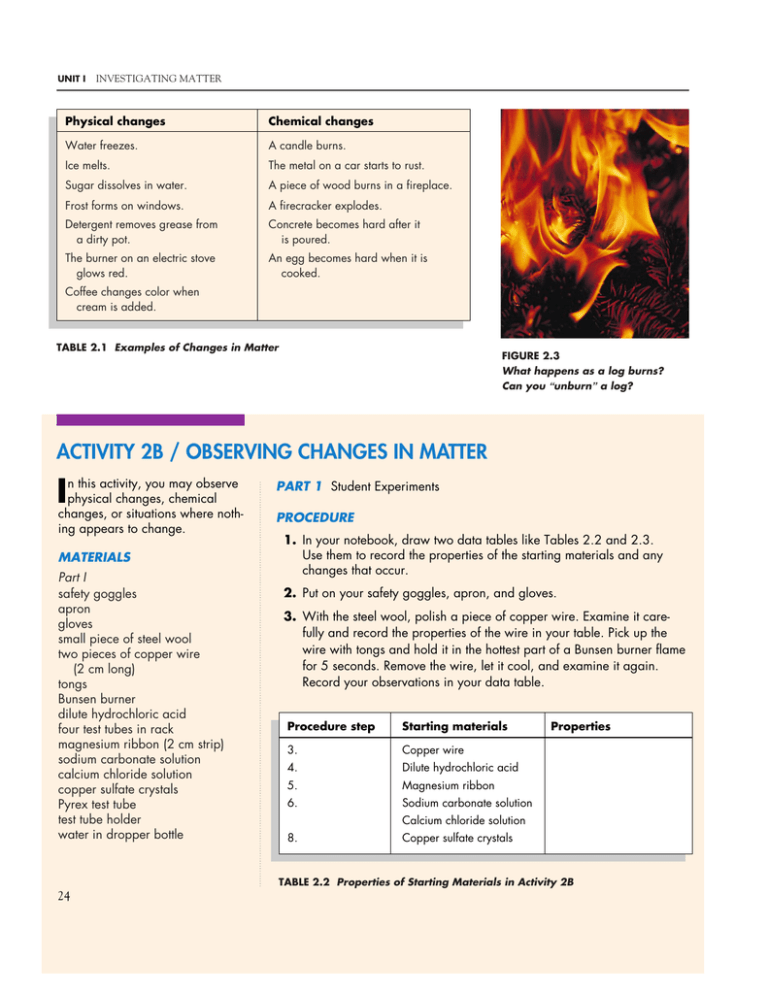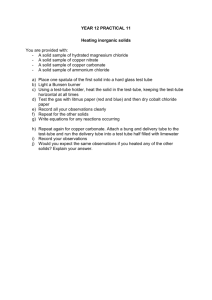activity 2b / observing changes in matter
advertisement

UNIT I INVESTIGATING MATTER Physical changes Chemical changes Water freezes. A candle burns. Ice melts. The metal on a car starts to rust. Sugar dissolves in water. A piece of wood burns in a fireplace. Frost forms on windows. A firecracker explodes. Detergent removes grease from a dirty pot. Concrete becomes hard after it is poured. The burner on an electric stove glows red. An egg becomes hard when it is cooked. Coffee changes color when cream is added. TABLE 2.1 Examples of Changes in Matter FIGURE 2.3 What happens as a log burns? Can you “unburn” a log? ACTIVITY 2B / OBSERVING CHANGES IN MATTER I n this activity, you may observe physical changes, chemical changes, or situations where nothing appears to change. MATERIALS Part I safety goggles apron gloves small piece of steel wool two pieces of copper wire (2 cm long) tongs Bunsen burner dilute hydrochloric acid four test tubes in rack magnesium ribbon (2 cm strip) sodium carbonate solution calcium chloride solution copper sulfate crystals Pyrex test tube test tube holder water in dropper bottle PART 1 Student Experiments PROCEDURE 1. In your notebook, draw two data tables like Tables 2.2 and 2.3. Use them to record the properties of the starting materials and any changes that occur. 2. Put on your safety goggles, apron, and gloves. 3. With the steel wool, polish a piece of copper wire. Examine it carefully and record the properties of the wire in your table. Pick up the wire with tongs and hold it in the hottest part of a Bunsen burner flame for 5 seconds. Remove the wire, let it cool, and examine it again. Record your observations in your data table. Procedure step Starting materials 3. Copper wire 4. Dilute hydrochloric acid 5. Magnesium ribbon 6. Sodium carbonate solution Properties Calcium chloride solution 8. Copper sulfate crystals TABLE 2.2 Properties of Starting Materials in Activity 2B 24 CHANGES IN MATTER Procedure step Description of change Type of change (physical or chemical) CHAPTER 2 Reasons for classification as physical or chemical 3. 4. etc. FIGURE 2.4 Heating copper sulfate TABLE 2.3 Sample Data Table for Activity 2B C C A U T I O N ! ■ Dilute hydrochloric acid is very corrosive and can cause damage to eyes and skin. If you get any in your eyes or on your skin, immediately rinse with cold water for 15 or 20 minutes and inform your teacher. ■ Copper sulfate is poisonous. When heating the test tube, hold it pointing away from yourself and everyone else. 4. Carefully pour dilute hydrochloric acid into a test tube to a depth of about 4 cm. Polish the second piece of copper wire as you did in step 3 and carefully place it in the dilute hydrochloric acid. Leave it in the acid as you continue with Steps 5 to 7. Then observe the wire carefully and describe any changes in your data table. 5. With the steel wool, polish a piece of magnesium ribbon. Examine it carefully and record the properties of the magnesium ribbon in your data table. Pour dilute hydrochloric acid into a test tube to a depth of about 4 cm. Add the magnesium ribbon to the test tube; describe any changes. 6. Carefully pour sodium carbonate solution into one test tube and calcium chloride solution into another, both to a depth of about 2 cm. Examine each solution and record the properties of each in your data table. 7. Slowly and carefully pour one solution into the other. Describe any changes that you observe in your data table. 8. Place approximately 2 g of copper sulfate crystals in a Pyrex test tube. Hold the test tube as shown in Figure 2.4 and heat the crystals for 10 s. Allow the tube to cool, then heat it again. Replace the test tube in the rack and allow it to cool completely. Record your observations in your data table. 9. Add a few drops of water to the crystals. Record your observations in your data table. MATERIALS Part II ammonium chloride in Pyrex test tube test tube holder glass wool Bunsen burner 10. Dispose of the materials according to your teacher’s instructions. 11. Wash your hands thoroughly after you have completed the activity. DISCUSSION 1. Why did you have to wear safety goggles, an apron, and gloves to carry out these experiments? ➥ 25 UNIT I INVESTIGATING MATTER C C A U T I O N ! ■ Your teacher will carry out Part II of the investigation if the classroom has good ventilation. 2. Using the steel wool in Steps 3, 4, and 5 removed the evidence of a change. Why was it better to polish the copper wire and magnesium ribbon before studying them?. 3. (a) List all the solid substances used or produced in this experiment (If you do not know the name of the substance, include only a description in your list.) (b) Repeat part (a) for all liquids and all gases. 4. In Step 6, solutions of sodium carbonate and calcium chloride are used. Suggest a reason why these solutions are used rather than solid sodium carbonate and solid calcium chloride. ammonium chloride glass wool PART II Teacher Demonstration PROCEDURE 1. Your teacher will place one scoop of ammonium chloride in a Pyrex test tube. The test tube will be plugged with glass wool to slow the escape of any gas (Figure 2.5). The bottom end of the test tube will be heated gently over a flame for 3 seconds only and then allowed to cool. 2. Record your observations in your notebook. DISCUSSION FIGURE 2.5 Is there evidence of a change as the test tube cools? 1. What are some characteristics of physical changes? Give an example of a physical change with each characteristic. 2. What are some characteristics of chemical changes? ❖ DISTINGUISHING BETWEEN A PHYSICAL CHANGE AND A CHEMICAL CHANGE It is not always easy to tell the difference between a physical change and a chemical change. Some chemical changes may produce flames, sparks, and noise (Figure 2.6), but many do not. The chemical changes that take place when you bake a cake, polish brass, or clean the oven are much less spectacular. However, certain clues may tell you that a chemical change has occurred: FIGURE 2.6 This welder is using a chemical change to create a physical change. How does his oxyacetylene welding torch work? What are the two changes? 26 • • • • • A new color may appear. Heat or light may be given off. Bubbles of gas may be formed. Solid material may form in a liquid. The change may be difficult to reverse. Any of these clues could also be part of a physical change. You need to consider several clues in order to determine which type of change has taken place.




